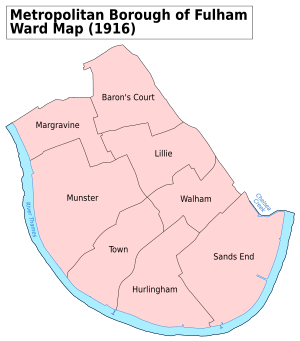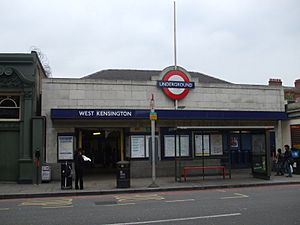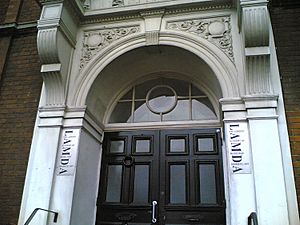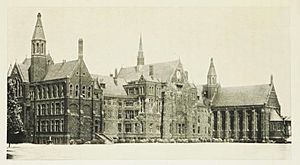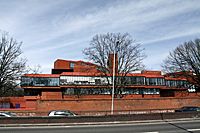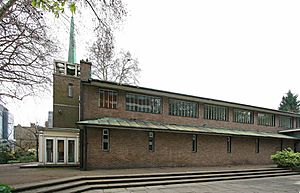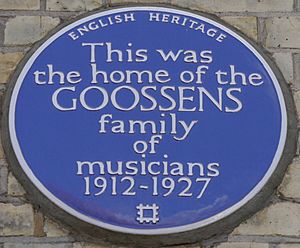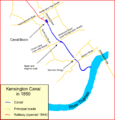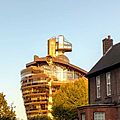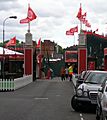West Kensington facts for kids
Quick facts for kids West Kensington |
|
|---|---|
| OS grid reference | TQ246783 |
| London borough | |
| Ceremonial county | Greater London |
| Region | |
| Country | England |
| Sovereign state | United Kingdom |
| Post town | LONDON |
| Postcode district | W14 |
| Dialling code | 020 |
| Police | Metropolitan |
| Fire | London |
| Ambulance | London |
| EU Parliament | London |
| UK Parliament |
|
| London Assembly | |
West Kensington, formerly North End, is an area in the ancient parish of Fulham, in the London Borough of Hammersmith and Fulham, England, 3.4 miles (5.5 km) west of Charing Cross. It covers most of the London postal area of W14, including the area around Barons Court tube station, and is defined as the area between Lillie Road and Hammersmith Road to the west, Fulham Palace Road to the south, Hammersmith to the north and West Brompton and Earl's Court to the east. The area is bisected by the major London artery the A4, locally known as the Talgarth Road. Its main local thoroughfare is the North End Road.
It is predominantly a dense residential area with the Queen's Club in its midst and is bordered by the Lillie Bridge railway depot, the now defunct Earls Court Exhibition Centre site, Olympia Exhibition Centre and the commercial centres at Fulham and Hammersmith Broadway.
Contents
History
In 1876 William Henry Gibbs and John P. Flew, builders from Dorset, decided to capitalise on their modest success in Kensington, by recreating another 'South Kensington' on the market gardens west of the West London Railway. They built 1,200 houses in the village of North End in the parish of Fulham. However, the housing slump of the 1880s left them with many unsold properties. Their response was two-fold, to have North End renamed as 'West Kensington' and to build a bridge over the railway, from their estate to link with the Cromwell Road in fashionable Kensington. They succeeded with the first plan, but the second led to bankruptcy and the dissolution of the partnership in 1885. However, the campaign for the bridge was taken up by local residents and the West Cromwell Road bridge was eventually commenced in 1938 and opened in 1942. Gibbs and Flew thereafter carried on separate businesses with a measure of success in Fulham.
Residential
West Kensington is primarily a residential area consisting mainly of Victorian terraced houses, many of which are subdivided into flats. There are excellent examples of Victorian architecture, with several houses and some entire streets listed – including the imposing mansion blocks of Fitzgeorge Avenue (off North End Road) and the mansion blocks around Avonmore Road including, Glyn Mansions (Built 1897), Avonmore Mansions and Avonmore Gardens (Built 1893) which is located next to the new Kensington Village development. West Kensington Court was purpose built and completed in 1938 with a view of providing what were considered at the time luxury flats for young professionals and families wishing to move from older-style properties. There are also a number of ex-local authority and local authority buildings around the North End Road, including the recently renovated Lytton Estate. Many of buildings have been sold off. A more recent private development, St Paul's Court, was built in 1980 on the former site of St Paul's School.
Demographics
West Kensington is a cosmopolitan enclave. There are significant populations of Arabs, Americans, Australians, New Zealanders, Irish, Italian, Spanish, and French, for some of which private schools teaching in their native language can be found around Brook Green. The area also has a large student population, as it is close to Imperial College London, Charing Cross Hospital, South Kensington, Hammersmith and other Central London Universities.
Location
West Kensington has a major advantage in its location. Spill-over wealth from Kensington (W8) means that the area has brought more speciality shops, catering establishments and other developments. West Kensington straddles the border between the boroughs of Hammersmith & Fulham and Kensington & Chelsea. Although the area has not experienced the same level of investment and rejuvenation as neighbouring Earl's Court and Fulham, new building and renovation work continue. W14 became the first London postcode area without a post office, until a sub-post office agreement was reached with North End News in February 2009.
 |
Shepherds Bush & Hammersmith | Shepherds Bush & Notting Hill | Notting Hill & Holland Park |  |
| Hammersmith | Kensington | |||
| Fulham & Hammersmith | Fulham & Earl's Court | Earl's Court & South Kensington |
Transport
West Kensington is well served by public transport.
- There are three London Underground stations in W14 plus a "virtual" station:
- West Kensington (District line)
- Barons Court (District and Piccadilly lines)
- Kensington (Olympia) (District line and London Overground)
- There are seven more in the vicinity:
- Hammersmith (District and Piccadilly lines)
- Hammersmith (Circle and Hammersmith & City line lines)
- Earl's Court (District and Piccadilly lines)
- High Street Kensington (District line)
- Fulham Broadway (District line)
- West Brompton (District and London Overground)
- Gloucester Road (District, Circle and Piccadilly lines)
- Goldhawk Road (Hammersmith & City and Circle lines)
- Shepherd's Bush (Central and Hammersmith & City lines)
West Kensington station is on the District line linking Upminster with Ealing Broadway station and Richmond. There is a branch line (running between Kensington Olympia-Earl's Court-Kensington High Street) and the Piccadilly line from Barons Court, the Hammersmith & City line from Hammersmith tube station, and the Central line from Shepherd's Bush and Holland Park.
- Overground: The London Overground is available from West Brompton station, Kensington (Olympia) station and Shepherd's Bush.
- Bus: Several Bus routes are available in the area including the 9, 23, 27, 28, 49, 306 and C1. Along Hammersmith Road, there are numerous buses linking the area to Acton, Aldwych, Chiswick, Hammersmith, King's Cross, Notting Hill, Oxford Street, Paddington, Richmond and Trafalgar Square. The N9 bus also runs from Olympia to Heathrow Airport via Isleworth and West Middlesex Hospital.
- Road: West Kensington is also close to the A4 (West Cromwell Road) with links to the West and Heathrow and High Street Kensington with links to the Central London/West End.
A local trasport related curiosity (and not open to the public) is the London Underground training centre that contains a mock-up station called West Ashfield tube station. It is located on the third floor of Ashfield House. Despite its recent erection, it is scheduled for demolition as part of the Earls Court Regeneration Scheme.
Nearest locations and places of interest
- Queen's Club – home to The Queen's Club Championships
- Olympia Exhibition Centre
- Sotheby's central London sales room is located at the Olympia
- Blythe House stores and off-site facilities for Victoria & Albert, Science and British Museums
- North End Road Market
- Charing Cross Hospital
- Earls Court Exhibition Centre
- Kensington High Street
- Holland Park
- Hyde Park
- Fulham Broadway
- Hammersmith Broadway
- Hammersmith Apollo
- Westfield London
Cultural associations
Blythe House has been used as a filming location for numerous films including Tinker Tailor Soldier Spy.
In the film Trainspotting, the flat that Renton shows the young couple around when he gets the job as an estate agent and ultimately stashes Begbie and Sickboy in is 78A North End Road, opposite West Kensington tube station.
The Nashville Rooms, now the Famous Three Kings pub, hosted many rock and punk concerts in the 1970s and early 1980s. Joy Division, The Sex Pistols and The Police all played there regularly.
In Hanif Kureishi's novel The Buddha of Suburbia, the main character moves from the southern suburbs of London to West Kensington and lives by the Nashville. He witnesses one of the first presentations of a punk band, probably The Sex Pistols.
The flat featured in the 1969 BBC series 'Take Three Girls' was at 17 Glazbury Road.
Heather Graham and Mia Kirshner play upper-middle-class dilettantes from West Kensington in the 2008 movie Buy Borrow Steal.
Future redevelopment
The London Borough of Hammersmith & Fulham and the Royal Borough of Kensington & Chelsea have resolved to grant outline planning permission for Sir Terry Farrell's Masterplan for the Earl's Court Project. As the Earls Court Project would bring considerable benefits to the area, it was recognised by the Mayor’s London Plan as an Opportunity Area in July 2011. The project, expected to span 15-20 years, would involve the redevelopment of the land around the Earl's Court Exhibition Centres and the West Kensington & Gibb's Green Estate. The proposals include the redevelopment and creation of four new village centres around North End Road, West Kensington, West Brompton and Earl's Court.
Commerce, education and religion
Local business consists of small shops, offices and restaurants, with the Olympia Exhibition Centre nearby. West Kensington is within easy reach of Earl's Court, and the Broadways of Fulham and Hammersmith. There are several pubs and hotels, including The Albion public house, which is reputedly haunted. The Baron's Court Theatre is located in the basement of The Curtains Up bar and restaurant. One of the oldest extant Polish Patisserie-delicatessens in London, Prima, was opened in North End Road in 1946. For several decades after World War II, the editorial offices of the Polish Daily, the UK's oldest Polish language paper, were located in Charleville Road. The Carnival Store is a longstanding fancy dress and costume shop in Hammersmith Road and family owned for the past 40 years.
In February 2009, the W14 postcode became the first London postal area without a post office, until a sub-post office agreement was reached with the retail outlet, North End News.
Education
West Kensington once had on its fringes the dominating presence of a terracotta cluster of Neo Gothic buildings amid lush playing fields, of St Paul's School backing onto the Talgarth Road, between 1884 and 1968. It has since migrated to its fifth set of buildings now south of the Thames river in Barnes, since it left, centuries ago, the old cathedral cloister in the City of London. A junior feeder school which moved with it, was the preparatory Colet Court, started in Edith Road in 1881, then on Hammersmith Road and is now renamed St Paul's Juniors in Barnes. Part of the old St Paul's site in Hammersmith is occupied by one of four campuses of the FE Ealing, Hammersmith and West London College, and by the Parayhouse Educational facility. West Kensington has two St James Independent Schools, for juniors and senior girls. Fulham Boys School, a new independent school, has been temporarily housed in a former Local education authority special school on Mund Street W14, while the Fulham Police station site off Fulham Broadway becomes the school's new premises.
The London Academy of Music and Dramatic Art (LAMDA), one of UK's leading theatre schools, moved in 2005 into the former premises of the Royal Ballet School at 153-155 Talgarth Road, after years in Earl's Court.
Religion
Despite its name, the church of St Andrew's, Fulham Fields is located in West Kensington. It was built by Newman and Billing in 1873, consecrated in 1874, and enlarged by Aston Webb and Ingress Bell in 1894.
West Kensington's main parish church, St Mary's, is located in Hammersmith Road, near the junction with Edith Road. The original church building was built in 1813 and given its own parish in 1836. In June 1944 the church building was completely destroyed by a V1 flying bomb. The present church building dates from the 1960s.
Notable people
- Edward and Georgiana Burne-Jones, he a Pre-Raphaelite painter, she a writer, resided at the Grange, in what is now the Lytton Estate, West Kensington.
- John Melhuish Strudwick, Pre-Raphaelite painter, resided at Edith Villas during the 1880s and into the 1890s.
- Maude Goodman a.k.a. Matilda Scanes, artist, resided at Edith Villas until 1894, and then 7 Addison Crescent until her death in 1938. From 1938 to 1968 the Maude Goodman Studio operated musical recitals there with Dame Eva Turner as president.
- Edward Compton, actor-manager lived and died at 54 Avonmore Road.
- William Crathern, composer, was organist of St Mary's, West Kensington (at that time known as North End).
- Edward Elgar, composer, lived at 51 Avonmore Road, W14, 1890–1891.
- Estelle, rapper, was born and raised in West Kensington; her song "1980" was written about growing up in the area.
- Charles James Feret, Fulham historian, editor of the Fulham Chronicle and author of Fulham Old and New (1900), lived in Edith Road.
- Mahatma Gandhi, lived on 20 Barons Court Road (West Kensington) while studying law.
- Marcus Garvey, Pan Africanist, founder of the Black Star Line shipping company and the Universal Negro Improvement Association and African Communities League, lived and died in West Kensington.
- Eugène Goossens, fils, Belgian musician, his singer wife, Annie Cook and their children, Sir Eugène Goossens, conductor, harpists, Sidonie and Marie Goossens and brothers, Adolphe and Léon, horn and oboe players respectively, lived at 70, Edith Road West. A blue plaque commemorates them.
- Sir Robert Gunter was a Yorkshire and Chelsea-based member of the wealthy landowning confectioners, the Gunter family, who developed large swathes of West London. Street names like Gunterstone and Edith commemorate Gunter family members.
- Henry Rider Haggard, author, lived for several years in Gunterstone Road and wrote King Solomon's Mines and She while there.
- Adelaide Hall Jazz singer and entertainer lived at 54A Fairholme Road until her death in 1993.
- Stephen Hester, chief executive, Royal Bank of Scotland
- James Hunt, Formula 1 champion, lived in Normand Mews, 1980–82.
- James MacLaren, architect, designed 22 and 22A Avonmore Road for sculptor HR Pinker.
- Stirling Moss, British former Formula One racing driver, was born in West Kensington in 1929
- Sir William Palliser, Irish-born conservative politician who built several terraced streets in North End.
- Mary Ann Sieghart writer, broadcaster and assistant editor of The Times was born in the area.
- Sir John Tenniel (1820–1914), artist and cartoonist, lived at 52 FitzGeorge Avenue, West Kensington until his death on 25 February 1914.
- William Worby Beaumont (1848-1929), engineer and inventor, lived at 76 Gunterstone Road. The local Beaumont Avenue is a memorial to him.
- William Butler Yeats lived in Edith Villas with his family in 1867.
Images for kids
-
The Ark, Hammersmith
-
Entrance to Queen's Club during the 2005 Queen's Club Championships



